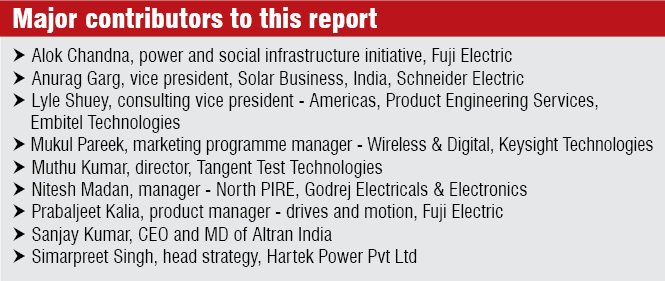Solar modules have become a commodity these days because there are many players in this space and there is very little invention happening. However, inverters are one area where there is change happening, especially on inverter-optimisation technology to help with domestic installations.
Anurag Garg, vice president, Solar Business, India, Schneider Electric, thinks that a big focus would be on storage. “This is because in renewables, usually a large part of the power requirement is consumed over a short period of the day and then you need to figure out how to source power when it is not there. So stabilising the grid is the challenge, and storage will be one of the biggest solutions here,” he adds.
Schnieder is also working on a pilot project with this aim. Rooftop-level storage solutions are okay, but storing it in power plants where storage has to scale to megawatts is the challenge.
Singh says, “At Hartek Power, our focus is on connecting renewable power to the grid and making the entire grid smart by implementing various automation techniques so that the entire power-system value chain can be controlled. We have connected close to 150MW of solar power to the grid and another 100MW is in pipeline, which should be achieved by March 2016 through our power systems and sub-station expertise. Our fundamental concern is that, with so much attention given to generation, the transmission and distribution space should not get ignored, since the grid has to be made fully equipped.”
Equipment
Over a period of five years, test and measurement equipment in this category have been gaining momentum. “Early testers were more or less general-purpose testing units that were employed in the renewable energy sector. Now, more refined specific test systems for photovoltaic, wind and geothermal power generation are in force. Capabilities such as onsite and online data logging for wind and solar energy sectors are in vogue now,” explains Muthu Kumar, director, Tangent Test Technologies.
While building photovoltaic cells, panels and solar arrays, engineers test the micro-inverter by simulating cell behaviour for sunny, cloudy, rainy or dark days and other similar weather changes using a normal power supply, which is very hard to do. The transition from sunny to rainy needs a power supply with substantial power and high wattages, while being capable of modulation from low to mid to high.
To make things easier for these engineers, Keysight’s N89xxAPV photovoltaic array simulator is one recent launch that drops down voltage and power levels based on sunny days going to cloudy and then to rain without the engineer having to code. “Moreover, the new GUI allows you to drag and drop a cloud or rainy environment, or change the time of rain and more. When manufacturers make solar products, they create these based on the region they want to serve. So a US-focused product might be tuned to work without a lot of sun but an Indian version might get a lot of sun. The new simulator allows them to test micro-inverters based on region by easily changing weather conditions,” opines Mukul Pareek, marketing programme manager – Wireless & Digital at Keysight Technologies.

High-accuracy power meter Hioki PW6001 is an industry-leading 0.02-per-cent-accuracy power analyser that can measure new-generation devices like insulated-gate bipolar transistors (IGBTs) that have very high efficiencies. “There is going to be a lot of difference when a power meter qualifies an inverter as 98 per cent efficient or 98.3 per cent efficient. This minor difference will help engineers conserve a lot of energy when there are solar and wind power plants that generate GW of power,” adds Muthu Kumar.
What is next
Singh says, “An ideal smartcity or ideal sustainable solution is when I have an independent power plant at my home and it lets me sell or buy power whenever I want. This is something that will be sustainable. Dependency on fossil fuels has to finish, it cannot go on forever.”
What we foresee is that there need to be pre-fabricated structures for different roofs that let you easily affix modules and install like a consumer product. Currently, a non-technical person has to consult an engineer or a technician for installation. In the end, the whole system will have to be so easy to install and prices will have to drop so much that one could order online and install without outside help. “Solar energy as a service will be the next big thing,” adds Singh.
As you can see, a lot depends on the Sun. What would we do if something happens to it? Well SolarCity founder Elon Musk announced his desire to trigger nuclear bombs above Mars every few seconds to warm up the planet! Hopefully, someone will find a more subtle idea for Earth.
Dilin Anand is a senior assistant editor at EFY. He is B.Tech from University of Calicut, and is currently pursuing MBA from Christ University, Bengaluru
Sneha Ambastha is a technical journalist at EFY




